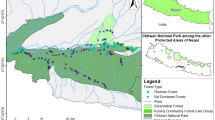Abstract
This paper reports observations of flocking behavior of birds in a well-protected secondary forest in Tai Po Kau Nature Reserve, Hong Kong Special Administrative Region, China. A total of 1025 flocks including 5255 birds and 48 species were observed between October 2002 and November 2003. Most flocks consisted of only one species. The observed flocks averaged 1.79 ± 0.05 (SE) species and 5.13 ± 0.18 (SE) birds. The Japanese White-eye was the most numerous species and was present in 21.6% of the observed flocks. Seasonal trends in both flock size and number of species were similar to those in overall bird density and species richness in the study area reported in a previous study.





Similar content being viewed by others
References
Alves MAS, Cavalcanti RB (1996) Sentinel behavior, seasonality, and the structure of bird flocks in a Brazilian savanna. Ornitol Neotropical 7:43–51
Benkman CW (1997) Feeding behavior, flock-size dynamics, and variation in sexual selection in crossbills. The Auk 114(2):163–178
Gaddis P (1980) Mixed flocks, accipiters, and antipredator behavior. The Condor 82:348–349
Gram WK (1998) Winter participation by neotropical migrant and resident birds in mixed species flocks in Northeastern Mexico. The Condor 100:44–53
Hutto RL (1987) A description of mixed-species insectivorous bird flocks in Western Mexico. The Condor 89:282–292
Hutto RL (1994) The composition and social organization of mixed species flocks in a tropical deciduous forest in Western Mexico. The Condor 96:105–118
King ID, Rappole JH (2000) Winter flocking of insectivorous birds in montane pine-oak forests in Middle America. The Condor 102:664–672
Kwok HK (1996) Seasonality of forest birds in Hong Kong. PhD Thesis, The University of Hong Kong
Kwok HK (2007) Changes of a forest bird community in Hong Kong, South China in 10 years. Acta Ecol Sin 27(10):3993–4001
Kwok HK (2009) Foraging ecology of insectivorous birds in a mixed forest of Hong Kong, South China. Acta Ecol Sin 29(6):341–346
Kwok HK (2011) Seasonality of a forest bird community in Hong Kong, South China. Hong Kong Bird Report 2005/2006:227–232
Latta SC, Wunderle JM (1996) The composition and foraging ecology of mixed-species flocks in pine forests of Hispaniola. The Condor 98:595–607
Mackinnon J, Phillipps K, Shower D (2000) A field guide to the birds of China. Oxford University Press, Oxford, p 600
Powell GVN (1979) Structure and dynamics of interspecific flocks in a neotropical mid-elevation forest. Auk 96:375–390
Quay WB (1982) Seasonal calling, foraging, and flocking of Inca doves at Galveston, Texas. The Condor 84:321–326
Sullivan K (1985) Selective alarm calling by Downy Woodpeckers in mixed-species flocks. Auk 102:182–187
Thiollay JM (2003) Comparative foraging behavior between solitary and flocking insectivorous in a neotropical forest: does vulnerability matter? Ornithol Neotropical 14:47–65
Valburg LK (1992) Flocking and frugivory: the effect of social grouping on resource use in the Common Bush-Tanager. The Condor 94:358–363
Waite TA, Grubb TC (1988) Copying of foraging locations in mixed-species flocks of temperate-deciduous woodland birds: an experimental study. The Condor 90:132–140
Zhang Q, Han R, Huang ZL, Zou FS (2013) Linking vegetation structure and bird organization: response of mixed-species bird flocks to forest succession in subtropical China. Biodivers Conserv 22:1965–1989
Zou FS, Chen GZ, Yang QF, Fellowes JR (2011) Composition pf mixed-species flocks and shifts in foraging location of flocking species on Hainan Island, China. Ibis 153:269–278
Acknowledgements
This paper was reviewed by Professor Richard Corlett of Xishuangbanna Tropical Botanical Gardens, C.A.S., Yunnan. His helpful comments and suggestions are gratefully acknowledged.
Author information
Authors and Affiliations
Corresponding author
Additional information
The online version is available at http://www.springerlink.com
Corresponding editor: Thomas D. Dahmer.
Rights and permissions
About this article
Cite this article
Kwok, H.K. Flocking behavior of forest birds in Hong Kong, South China. J. For. Res. 28, 1097–1101 (2017). https://doi.org/10.1007/s11676-017-0373-z
Received:
Accepted:
Published:
Issue Date:
DOI: https://doi.org/10.1007/s11676-017-0373-z




